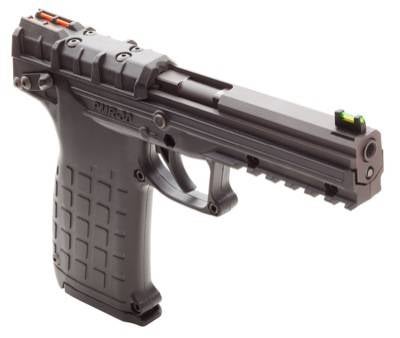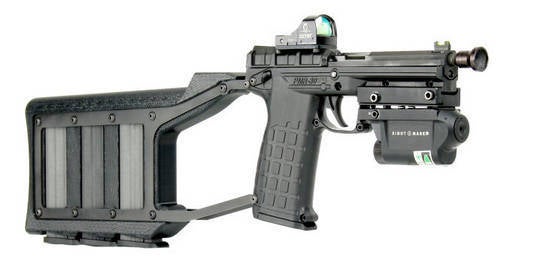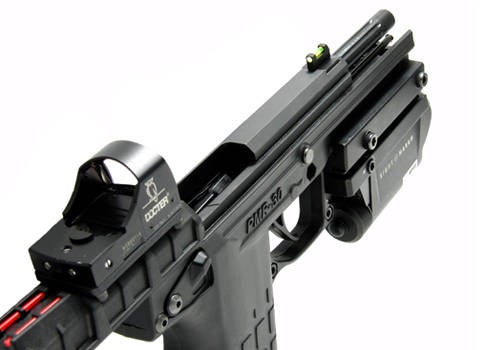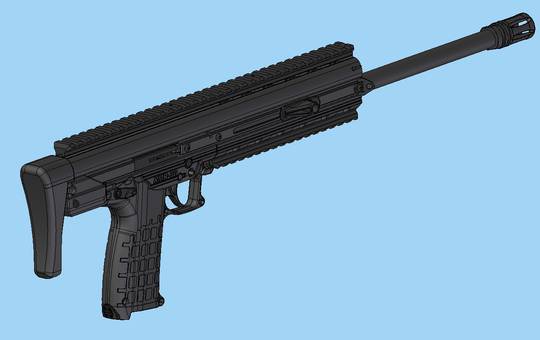Tobias Obermeit, the Chief Design Engineer on the PMR-30 pistol at Kel-tec, generously offered to allow you (the readers) to submit questions for him to answer. Many questions were similar so I merged them into a single question.

There were a lot of question and I cannot thank Tobias enough for taking the time to answer them. I know that I have learn’t many things that I was not aware before.
PMR-30 Questions
.
How much commonality is there between the new PMR-30 and the Grendel .22 WMR pistol?
Zero parts commonality. The only commonality design wise is the interior
of the magazine. The way the magazine stacks the 30 rounds of 22WMR ammo is
nearly the same. But every other part of the design is new and often very
different. Trigger mechanism is better, The PMR-30 has a last shot bolt hold
open, which the grendel did not. The grendel had a fluted chamber, the
PMR-30 does not need this because of the hybrid locking system.
Are there any plans for a carbine version of the PMR-30 like the old Grendel R-31?
Yes, I am working on it right now. there are pictures of the current
prototype design shown here. Availability and price is unknown at this
point.

Are there any plans to produce a low-cap (10 round) magazine for those of us who live in capacity restrictive states like NY?
There are plans to offer a magazine block of some sort that could be
used to limit magazine capacity (10, 15, or even 20 rounds could be done).
But there are no plans to mold a special magazine for this, at this time.
Do you believe that the .22 WMR is an adequate man-stopper?
I do not believe that a single .22WMR out of a pistol is adequate…but
I do believe 25 to 30 .22WMR’s are adequate. It’s not ideal, but the total
amount of bullet weight in a full 30 round mag is 1500 grains (if 50 grain
bullets are used). This compares to 10 rounds of 147 grain 9mm, or 13 rounds
of 115gr. Of course bullet weight alone is not enough, but the velocity out
of the PMR-30 is still quite good. (1230fps for 40 gr)
Do you have any word on .22 WMR loadings from any manufacturers that are optimized for pistol-length barrels?
No, but I have asked the question of a few ammo manufacturers. I believe
it would only happen if there is a large spike in the demand for such
ammo….which could happen.
When will you be making a PMR-30 in 5.7×28mm or .22 Long Rifle?
5.7x28mm most likely never, It’s too long to fit in the grip of the
PMR-30. 22LR would be a better fit, but will only be done if we can get 30
rounds in the magazine to feed reliably….which is not easy.
Why so short a barrel? Will there be a longer barrel/target version?
The barrel length was chosen to be the shortest possible for a 22WMR
autoloader, in order to be as compact and lightweight as possible. Compact
and lightweight is what Kel-Tec is known for. There are plans for a 5 inch
threaded barrel for use with a flash suppressor, or even perhaps silencers.
But this will not be released until we know that the extra weight of a
silencer attached to the barrel will not adversely affect the hybrid locked
breech system.

Nobody asked how the hybrid-blowback system worked, so Tobias explained …
The hybrid locked/blowback system is simple in execution. There is
technically no mechanical locking system in the gun. The cartridge case is
the mechanical lock in the system.The friction of the case locks the chamber (and therefore the barrel) to
the case as they both recoil together….as long as the pressure is high
enough. lower pressure rounds will cause less friction between the case and
the barrel, and then the barrel stays still, or only moves a little…..It’s
a balancing act between the bullet friction pulling the barrel forward, and
the case friction in the chamber pulling the barrel back. Bullet friction
does not change much based on round pressure, but the case friction will.
KEL-TEC Questions
.
From a multi-caliber point of view, If you had a bullpup in 762 how easy
would it be to change to 556 – different lower, same upper and bolt carrier?
In theory the grip/forend assembly could be the same, and a new
barrel/receiver/bolt/carrier assembly could be attached. Unfortunately since
the receiver is legally the gun, this would not be a simple caliber
conversion that could easily be purchased separately. It would legally be a
new firearm.
Are Kel-Tec angry with Ruger for using their P3AT design aesthetic for the
LCP?
No anger, copying is part of the firearms business, and I am sure you
will see the P3AT style trigger mechanism in many other pistols (Taurus
comes to mind). Personally, I was not happy that Ruger claimed to have a
brand new design, when it was clearly based on our design, though. And when
an upgrade to the trigger mechanism I designed found it’s way into the ruger
after coming out in the P3AT, it didn’t make me feel any better. But that
is the business.
Does Kel-Tec plan on exporting their pistols and rifles to Europe?
Some Kel-Tecs have actually been exported already. But the distributors
handled that in the past. Now with the newer export regulations, things are
a little tricky. But I believe there will be expansion in the export market,
even with the increased complexity of export regulations. I believe Canada
may see some Kel-tecs soon.
Will we ever see a Kel-Tec revolver?
Anything is possible…but I doubt it. It certainly would be innovative if it ever does happen, though.
Will we ever see a 7.62×39mm SU-16 that takes AK mags?
Probably not that takes AK mags, but I believe there are AR style
magazines that accept that caliber. Not saying it will or will not happen
though.
Does Kel-Tec have any plans for a larger caliber handgun?
No specific plans….and if we did have any, I couldn’t talk about them
anyway.
Gun Design Questions
.
What did Kel-Tec learn about bullpups in the development of the RFB?
Kel-Tec learned how to make a great trigger for a bullpup. Also, Since
the barrel and chamber is physically closer to the shooter, dealing with
parts heating up and deflection of vent gasses needs to be handled
differently as well. Forward ejection took a lot of R&D too.
What steps can high school and college students take to become a gun design
engineer?
Start designing and drawing up your designs. pen and paper is good, and
I always start there. I still keep a notebook with different design ideas
that I sketch up as I have them (not all firearm ideas). But when you can
get access to some 3D design software, perhaps in an art class or a design
class, start drawing stuff up in 3D. Doesn’t have to be guns, any mechanical
designs help you get experience in how to draw in 3D and how things work
together. Pay attention in physics, chemistry, math, and reading/writing
classes. You might not think reading and writing is that important but you
have to be able to communicate your ideas and designs with others.
In general, where is the starting point in designing a gun? Do you start
from scratch or base it on a previous model? What component is designed
last?
It depends on what you are trying to do. If you are designing for a
specific size and capacity you generally design from the magazine out. but
if you are just designing from scratch then basically you start from the
bullet back, or from a standard cartridge and barrel length which already
has an established energy and velocity. Usually you can use a common
magazine and you have an idea of rifle or pistol. Based on the energy and
pressure levels of the cartridge you are limited to certain types of cycling
action (blowback, or locked breech, or gas operated,…) then based on the
length and shape of the cartridge you can layout where the barrel starts and
how far the action has to travel and so on. Usually the parts that are not
primary functions of the gun are designed last, like slide stops, or sights,
or sling mounts.
Is it harder to find acceptance with a revised design over a new to market
design?
No,… but I’m not exactly sure what is being asked here. acceptance is a
relative term. I would say it is hard for a military to accept a new design
when comparing it to a tried and true design. But the civilian market is
often more accepting of new and innovative designs over old designs.
What CAD software do you use to design your firearms?
We use Solid Edge ST2 (version 21) currently, but started at version 14
I believe.
How much influence do the departments of accounting, finance, and marketing
have on weapon designs?
For Kel-Tec…not much. This is mainly due to the fact that the owner
(George Kellgren) has full control of accounting finance and marketing. What
he decides goes. But the sellability, market, and price point of the product
is certainly discussed. That is one of the benefits of a smaller, privately
owned company like Kel-Tec.
How does (BATFE and state) regulation fit into pricing?
Any legal requirement or special modification that needs to be done to
make a firearm legal in a certain state will add to the price, even if you
think it might not. Lets say one state won’t allow threads on a barrel. That
would mean we have to run a special batch of un-threaded barrels and make
sure they are built correctly and go to the right distributors. these
batches are usually much smaller than our standard batches and therefore can
cost more to setup and deal with. Gun locks are required by state and
federal law for each pistol, so that is added to the cost for all pistols.
I’m wondering who, in your informed opinion, are the great gun designers of
all time?
Personally I like Gatling. His rotary barrel type gun was revolutionary
and unique. Being a mechanical engineer, I really like the mechanisms with
gears and cams. Colts revolver mechanism is also quite nice, but Browning’s
slide locking mechanism has really taken over most modern designs….But I
think Gatling is my personal favorite.
What do you think will be the next great leap forward in gun design?
I’m not talking about layout changes (bullpup) or caliber/bullet shape.
If battery technology keeps progressing, perhaps some electronic
rail-guns will be possible, but that is at least a few decades away.
firearms are simple, effective, and proven. Perhaps some simpler and cheaper
electronic ignition systems. I don’t see anything specific that is on the
horizon right now. there are many new coatings that are becoming cheaper and
useful, I know I would love to use some carbon fiber in some designs, but
the cost is still rather high on that.
How do you measure the ‘timing’ of a breech-locking mechanism? I.e.
how do you make sure that the bullet has left the barrel and the pressure
dropped acceptably before the cartridge case starts to be pulled free of the
chamber [Ed: This comment refers to the Kel-tec RFB rifle. ]
This is done at the computer first, during the initial design process.
simple Newtonian physics combined with interior ballistics software can
predict pretty accurately how long a certain weight slide will take to
unlock and how much pressure is still in the barrel when this happens. Then
a prototype can be made and high-speed video can be used to verify this if
needed.
Do they use advanced brainstorming techniques and market research? Or is it
more of an “Eureka!” thing. Actually, do all the people involved in the
design have an extensive firearms background? Or is it sometimes those with
little prior firearms experience that bring in ideas from “outside the box”?
Kel-Tec has a small design team. about 3 to 6 people are involved in the
design to some extent, Generally one or two people will work primarily on a
design, and consult with others if issues or questions pop up. we do consult
with others who have some or even little firearm experience. Often these
other people mention issues that you would not think of. I did not come from
a firearms background when I first got this job, but I am certainly an
enthusiast now. The CEO (George Kellgren) has been professionally designing
guns since 1968, and we have machinists and technicians with military or
even competition shooting experience as well as those who have little
experience with firearms at all.Professional market research is not used. But a few of us do regularly
check the blogs (like this one) and forums and read magazines to get a good
idea of what is going on in the firearm communities as a whole.
The vast majority of polymer framed pistols use nylon-6 or some variant, but
until recently Ruger used a polyurethane “Isoplast”
polymer for its pistols (P95, P97 using it, SR9 apparently using nylon). Why
has nylon-6 been the overwhelming choice over other polymers?
Cost, Availability, and performance would be the reason to switch. There
are many reasons to choose one product over the other, perhaps it gets used
in multiple products, and buying in bulk will save money. the Nylon seems to
have the edge in handling heat over the isoplast. We have stuck with Nylon
from the beginning and have not had any need to switch, though we have
changed glass content in the nylon as needed to increase or decrease
stiffness.
Plastics/polymers are a relatively new material, with materials like nylon 6
seeing widespread use only in the last 60 years or so. How much do we know
about their long term durability? Should a buyer expect a Kel-Tec, Glock, or
other nylon-6 framed pistol to be completely reliable and as good as new in
30, 50, or 100 years?
30 years absolutely yes, 50 to 100 yes, if it is cared for correctly. As
long as the nylon is protected and cleaned with the correct products, it
should last as long as the steel, and certainly longer than wood. All the
modern polymers have add-ins that protect it from UV rays from the sun.
Early plastics did not have this and would eventually get brittle.
The RFB appears to be one of the more successful forward ejection bullpup
designs of late. Did you choose tilt-locking specifically because of the
extractor arrangement, or because perhaps you were working from a bullpupped
FAL?
The locking system is specific to the forward ejection system. The way
the extractors rotate up, does not allow the bolt to do anything but tilt.
FAL mags were chosen because the feed lips are setup to deal with a bolt
that tilts down into the magazine a little. (compared to an AR-10 mag which
does not need to deal with this)
When shopping for a new gun, what are the signs of a good design? A bad one?
Materials are the first thing I would look at. good quality material is
a must in any design. whether it is steel, aluminum, or plastic, or even a
casting. I personally stay away from zinc cast guns, but they can be
designed well these days. But the design should match the materials well. If
there are lots of sharp edges or corners in a cast or molded part, these
could be high stress areas that are likely to break in the future.
 Your Privacy Choices
Your Privacy Choices

